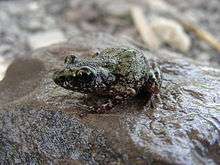Eleutherodactylus pipilans
Eleutherodactylus pipilans is a species of frog in the family Eleutherodactylidae. It is found in southern and southeastern Mexico (south-central Guerrero to southern Oaxaca to southern Chiapas) and southwestern Guatemala.[2]
| Eleutherodactylus pipilans | |
|---|---|
 | |
| Scientific classification | |
| Kingdom: | Animalia |
| Phylum: | Chordata |
| Class: | Amphibia |
| Order: | Anura |
| Family: | Eleutherodactylidae |
| Genus: | Eleutherodactylus |
| Subgenus: | Syrrhophus |
| Species: | E. pipilans |
| Binomial name | |
| Eleutherodactylus pipilans (Taylor, 1940) | |
| Synonyms[2] | |
|
Syrrhophus pipilans Taylor, 1940 | |
Taxonomy
Two subspecies are sometimes recognized:[2][3]
- Eleutherodactylus pipilans pipilans
- Eleutherodactylus pipilans nebulosus
E. p. nebulosus was first described as a separate species, but became treated as a subspecies by Duellman in 1958.[2][4] Common name nebulous chirping frog refers to this subspecies, whereas common name whistling chirping frog may either refer to the species as a whole or the nominotypical subspecies E. p. pipilans.[2] The subspecies differ in relative tympanum size and coloration.[3][5]
Description
Adult males measure 23–29 mm (0.91–1.14 in) and females 21–29 mm (0.83–1.14 in) in snout–vent length. Skin of the dorsum is smooth or shagreened.[5] The eyes are relatively large. The tympanum is visible and oval in shape. The arms are long while the legs are relatively short.[3] The dorsal background color is dark brown to slightly lighter brown. There are yellow, orange, light brown, or greenish blotches or spots. The limbs are banded. Males have vocal slits.[3][5]
Habitat and conservation
Its natural habitats are tropical seasonal forests[1] at elevations of 100–800 m (330–2,620 ft) above sea level.[2] Individuals are found in a range of microhabitats: on the rocks, on the ground, under rocks and debris,[1] and in a cave.[6] Although locally abundant and tolerating some habitat modification, it is threatened by habitat loss.[1]
References
- Santos-Barrera, G.; Canseco-Márquez, L.; Muñoz Alonso, A.; Acevedo, M. (2004). "Eleutherodactylus pipilans". IUCN Red List of Threatened Species. 2004: e.T56862A11533824. doi:10.2305/IUCN.UK.2004.RLTS.T56862A11533824.en.
- Frost, Darrel R. (2017). "Eleutherodactylus pipilans (Taylor, 1940)". Amphibian Species of the World: an Online Reference. Version 6.0. American Museum of Natural History. Retrieved 15 June 2017.
- "Eleutherodactylus pipilans". AmphibiaWeb. University of California, Berkeley. 2017. Retrieved 17 June 2017.
- Duellman, W. E. (1958). "A review of the frogs of the genus Syrrhophus in western Mexico". Occasional Papers of the Museum of Zoology, University of Michigan. 594: 1–15. hdl:2027.42/57032.
- Lynch, J. D. (1970). "A taxonomic revision of the leptodactylid frog genus Syrrhophus Cope". University of Kansas Publications, Museum of Natural History. 20: 1–45. doi:10.5962/bhl.part.2809.
- García-Padilla, E.; Mata-Silva, V. (2014). "Noteworthy distributional records for the herpetofauna of Chiapas, Mexico" (PDF). Mesoamerican Herpetology. 1: 293–295.
